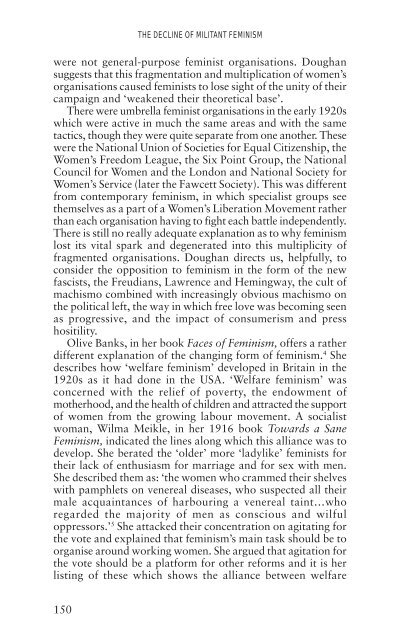The Spinster and Her Enemies - Feminish
The Spinster and Her Enemies - Feminish
The Spinster and Her Enemies - Feminish
Create successful ePaper yourself
Turn your PDF publications into a flip-book with our unique Google optimized e-Paper software.
THE DECLINE OF MILITANT FEMINISM<br />
were not general-purpose feminist organisations. Doughan<br />
suggests that this fragmentation <strong>and</strong> multiplication of women’s<br />
organisations caused feminists to lose sight of the unity of their<br />
campaign <strong>and</strong> ‘weakened their theoretical base’.<br />
<strong>The</strong>re were umbrella feminist organisations in the early 1920s<br />
which were active in much the same areas <strong>and</strong> with the same<br />
tactics, though they were quite separate from one another. <strong>The</strong>se<br />
were the National Union of Societies for Equal Citizenship, the<br />
Women’s Freedom League, the Six Point Group, the National<br />
Council for Women <strong>and</strong> the London <strong>and</strong> National Society for<br />
Women’s Service (later the Fawcett Society). This was different<br />
from contemporary feminism, in which specialist groups see<br />
themselves as a part of a Women’s Liberation Movement rather<br />
than each organisation having to fight each battle independently.<br />
<strong>The</strong>re is still no really adequate explanation as to why feminism<br />
lost its vital spark <strong>and</strong> degenerated into this multiplicity of<br />
fragmented organisations. Doughan directs us, helpfully, to<br />
consider the opposition to feminism in the form of the new<br />
fascists, the Freudians, Lawrence <strong>and</strong> Hemingway, the cult of<br />
machismo combined with increasingly obvious machismo on<br />
the political left, the way in which free love was becoming seen<br />
as progressive, <strong>and</strong> the impact of consumerism <strong>and</strong> press<br />
hositility.<br />
Olive Banks, in her book Faces of Feminism, offers a rather<br />
different explanation of the changing form of feminism. 4 She<br />
describes how ‘welfare feminism’ developed in Britain in the<br />
1920s as it had done in the USA. ‘Welfare feminism’ was<br />
concerned with the relief of poverty, the endowment of<br />
motherhood, <strong>and</strong> the health of children <strong>and</strong> attracted the support<br />
of women from the growing labour movement. A socialist<br />
woman, Wilma Meikle, in her 1916 book Towards a Sane<br />
Feminism, indicated the lines along which this alliance was to<br />
develop. She berated the ‘older’ more ‘ladylike’ feminists for<br />
their lack of enthusiasm for marriage <strong>and</strong> for sex with men.<br />
She described them as: ‘the women who crammed their shelves<br />
with pamphlets on venereal diseases, who suspected all their<br />
male acquaintances of harbouring a venereal taint…who<br />
regarded the majority of men as conscious <strong>and</strong> wilful<br />
oppressors.’ 5 She attacked their concentration on agitating for<br />
the vote <strong>and</strong> explained that feminism’s main task should be to<br />
organise around working women. She argued that agitation for<br />
the vote should be a platform for other reforms <strong>and</strong> it is her<br />
listing of these which shows the alliance between welfare<br />
150

















